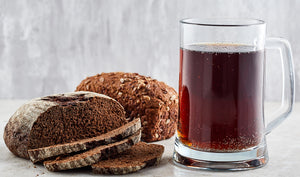Adding fruit to beer has been very popular for a long time. There’s just something so satisfying about adding 4 lbs of raspberries into your wheat beer and seeing it take on that red hue and smelling that mouth-watering aroma. For some brewers it can be intimidating adding fruit to their beer. This is mostly due to the risk of contaminating your beer with microbes found in the fruit. But this doesn't have to be the case. With the help of this article, you can brew with fruit worry-free!
Choosing your fruit
When you decide to make a fruit beer, you will first have to decide what fruit to use. You can get fruit in a few different forms, but have some pros and cons:
Fresh Fruit
Pros: Enhanced flavour and aroma profile, and can be more cost-effective.
Cons: Higher risk of contamination, and more work (usually required pitting and slicing).
Frozen Fruit
Pros: Contaminant free and convenient.
Cons: Potential flavour and aroma loss.
Fruit Puree/Concentrates
Pros: Pasteurized, easy, and usually more flavourful.
Cons: Usually not cost effective.
Extracts
Pros: Consistent and extremely easy.
Cons: "Fake" flavour.
How much to add
Now you come across the question - How much do I need to add to make the flavour shine through but not so much that it overpowers the whole beer. Follow these basic guidelines for adding fresh fruit to your beer.
Fruit |
lb/gal |
|
Apples |
0.5 - 1 |
| Apricots | 0.25 - 2 |
| Blackberries | 0.5 - 4 |
| Blueberries | 0.5 - 3 |
| Tart Cherries | 0.25 - 2 |
| Sweet Cherries | 0.33 - 4 |
| Citrus Fruits | 0.25 - 1 |
| Peaches | 0.5 - 5 |
| Pears | 0.5 - 2 |
| Plums | 0.5 - 2 |
| Raspberries | 0.25 - 2 |
Adding your fruit
Okay, it’s brew day and now your thinking, “when do I add this 10 lbs of cherries into my beer?” Well, there are a number of ways to do this. Here are some of the most common methods:
Mash
With this method, you will have no risk of contamination because it will all be boiled. However, you will notice a drastic loss in flavour. By the end end of the boil, most of the flavour compounds that the fruit contributed will have been boiled off.
Boil
This can be practical in some cases. You won't have to worry about infections, and it’s pretty easy to prep the fruit to go in. But you will still be stripping a lot of those flavour compounds from the fruit. A lot of the times you will get that “cooked fruit” flavour. For example, you will have a blueberry pie flavour, as opposed to a fresh picked ripe blueberry flavour.
Fermentation
Adding fruit into the fermenter is arguably the best way to get the maximum flavour of the fruit. However, if not prepped correctly, you run a huge risk of contaminating your beer. If you’re using extracts, concentrates, frozen fruit, or purees, you will be safe. If you're using fresh fruit, you will want to do some preparation.
Start by peeling and cutting the fruit, and remove pits in necessary. Next, you’ll want to get all those wild yeasts and bacteria out of the fruit. To do this, the easiest method is to freeze it. To ensure all of the contaminants are out of it, seal it in a freezer bag and freeze it for a minimum of 36 hours.
Once your fruit has been frozen, take it out the day before you want to use it and let it thaw. When it's thawed, mush it up and dump it into your fermenter. The safest way to this is to add it during the secondary fermentation and try to avid splashing. Try putting it into a cheesecloth bag and gently adding it into the fermenter. This will also make it easier when transferring out of the fermenter.
Leave the fruit in the beer for a week, taste it and if there’s not enough flavour, leave it for another week. Once it has enough flavour, package it and drink it fresh!



